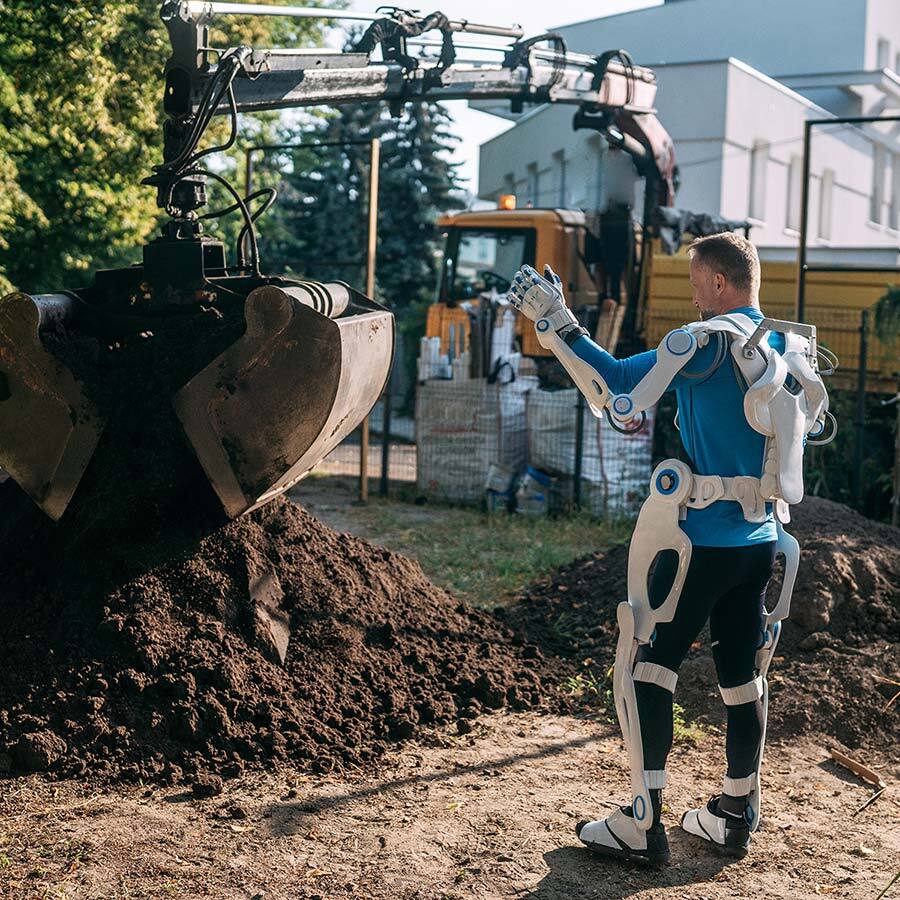Introduction
In these times of increasing occupational health and safety requirements, work-related musculoskeletal disorders (WMSDs) are a major issue for companies, due to the work stoppages they can cause. As a result, companies are looking for new ways to limit their workers’ exposure to the risks of MSDs, and are directing their attention particularly to exoskeletons.

The Canadian Centre for Occupational Health and Safety (CCOHS) defines “exoskeletons” as “wearable devices that can enhance, augment, or assist the user’s posture, motion, or physical activity.” Today, exoskeletons can be divided into two main categories: active and passive.
Active exoskeletons are equipped with motors or power generators designed to increase the strength of the body part to which they are attached. Passive exoskeletons allow users to adopt and maintain a posture usually considered uncomfortable, or to alleviate muscular tension by restoring mechanical energy with elastics, springs, rails or counterweights.
Further to the distinction between active and passive devices, exoskeletons can be classified based on the body part to which they are attached. In this paper, we will be focusing on lower-limb exoskeletons. These devices usually take the form of a harness with a seat and “legs” that act as a support in a sit-to-stand position.
The device could reduce the strain on muscle groups and delay the onset of pain associated with active sitting postures (INRS, 2023).

To the best of our knowledge, there are five models of lower limb exoskeletons on the market or coming to market: the Bionic Chair LEX developed by the start-up Astride Bionix, Honda’s Bodyweight Support System (H-BWS), Hyundai’s H-CEX, the Archelis products from the Japanese company Archelis, and the Chairless Chair 2.0 from the German company Noonee.
The Bionic Chair is the “mainstream” model and is designed to facilitate daily life in all circumstances—work, waiting for public transport and even during leisure activities.
The H-BWS, H-CEX and Chairless Chair 2.0 are intended for use in the automotive industry, specifically on assembly lines where workers don’t necessarily have the option of sitting down. The H-BWS is motorized and improves stability while climbing stairs. The last two devices use a harness attached to the body—wearers can adjust the seat height and angle as required.
Finally, the Archelis products were designed for both industrial and medical applications. They are intended for medical staff who must sit during long periods of work in the operating room.
So far, the potential benefits of these devices have been evaluated. The first is a reduction in muscular activity in the legs (Ikeuchi, Ashihara, Hiki, Kudoh, & Noda, 2009) and back muscles, which are essential for maintaining the sit-to-stand posture (MHLW, 2021). However, this benefit is conditional on the exoskeleton being used under predefined working conditions—working height limits, seat angles, etc. Otherwise, the user loses the muscular advantage of wearing the exoskeleton, and may even experience discomfort (Kong et coll., 2021).
Exoskeletons are also said to help distribute body weight more evenly, lightening the load on the feet while in a sit-to-stand position (Luger, Seibt, Cobb, Rieger, & Steinhilber, 2019 ; MHLW, 2021). That being said, although wearing an exoskeleton does not prevent the user from moving around, the work should be as static as possible. Otherwise, body weight distribution and fatigue reduction may not be as effective as in the sit-to-stand position (MHLW, 2021).
Finally, in addition to posture and motion, the effectiveness of exoskeletons also depends on their installation. If the wearer does not fully comply with manufacturer instructions, they may be risk falls or pain caused by a lack of protection (Kong et coll., 2021 ; MHLW, 2021).
Conclusion
Although exoskeletons could reduce the risk of musculoskeletal disorders affecting workers, they are far from being technologically mature, and involve certain challenges—mass of the device, practical acceptability, user comfort, and work-device adaptation (INRS, 2023). Further research is needed to better understand their advantages and disadvantages compared with conventional sit-stand workstations, and to improve their usability and practical acceptability in order to facilitate their deployment in the workplace.
References
Ikeuchi, Y., Ashihara, J., Hiki, Y., Kudoh, H., & Noda, T. (2009). Honda - Walking assist device with bodyweight support system. Dans 2009 IEEE/RSJ International Conference on Intelligent Robots and Systems (pp. 4073‑4079). https://doi.org/10.1109/IROS.2...
INRS. (2023). Exosquelettes - Dossier. INRS. Repéré à www.inrs.fr/risques/exosquelet...
Kong, Y.-K., Park, C.-W., Cho, M.-U., Kim, S.-Y., Kim, M.-J., Hyun, D. J., … Choi, K.-H. (2021). Guidelines for Working Heights of the Lower-Limb Exoskeleton (CEX) Based on Ergonomic Evaluations. International Journal of Environmental Research and Public Health, 18(10), 5199. https://doi.org/10.3390/ijerph...
Luger, T., Seibt, R., Cobb, T. J., Rieger, M. A., & Steinhilber, B. (2019). Influence of a passive lower-limb exoskeleton during simulated industrial work tasks on physical load, upper body posture, postural control and discomfort. Applied Ergonomics, 80, 152‑160. https://doi.org/10.1016/j.aper...
MHLW. (2021). Synthèse de l’étude du Archelis. Ministry of Health, Labour and Welfare (MHLW). Repéré à https://www.mhlw.go.jp/content...


